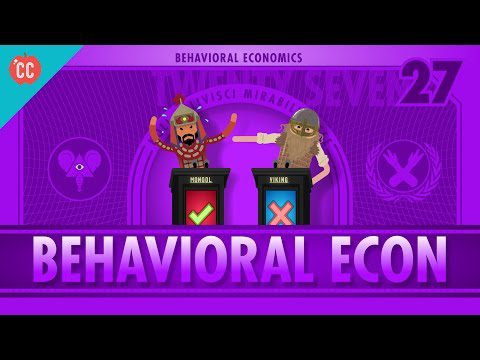De ce cumpără oamenii lucrurile pe care le cumpără? În economia clasică, majoritatea modelelor presupun că consumatorii se comportă rațional. După cum probabil ai observat în viața ta reală, de la caz la caz, oamenii nu iau de fapt decizii raționale. Pot exista motive emoționale sau sociale pentru toată această iraționalitate, iar economia comportamentală încearcă să abordeze acest lucru. Vom vorbi despre risc, teoria nudge, prețuri și percepție și jocul ultimatumului. Deci, să devenim iraționali, într-un mod logic, desigur.
Crash Course este pe Patreon! Ne puteți susține direct înregistrându-vă la http://www.patreon.com/crashcourse
Mulțumim următorilor Patroni pentru contribuțiile lor lunare generoase care ajută la menținerea Crash Course gratuită pentru toată lumea pentru totdeauna:
Mark, Eric Kitchen, Jessica Wode, Jeffrey Thompson, Steve Marshall, Moritz Schmidt, Robert Kunz, Tim Curwick, Jason A Saslow, SR Foxley, Elliot Beter, Jacob Ash, Christian, Jan Schmid, Jirat, Christy Huddleston, Daniel Baulig, Chris Peters, Anna-Ester Volozh, Ian Dundore, Caleb Weeks
—
Doriți să găsiți Crash Course în altă parte pe internet?
Facebook – http://www.facebook.com/YouTubeCrashCourse
Twitter – http://www.twitter.com/TheCrashCourse
Tumblr – http://thecrashcourse.tumblr.com
Curs intensiv de asistență pe Patreon: http://patreon.com/crashcourse
CC Copii: http://www.youtube.com/crashcoursekids
Cursuri interesante:
- Ecosystem Ecology: Links in the Chain – Curs intensiv Ecologie #7
- Politica fiscală și stimularea: Curs intensiv de economie #8
- Piețe, eficiență și semnale de preț: Economie de curs intensiv #19
- Despre ce este tot Yellen? Politica monetară și Rezerva Federală: Economie intensivă #10
- Mecanica cuantică – Partea 1: Curs intensiv de fizică #43
- Monopoluri și piețe anticoncurențiale: Curs intensiv de economie #25
- Legea gazelor ideale: curs intensiv de chimie #12
- Revoluția pieței: curs intensiv Istoria SUA #12
- Entropie: Îmbrățișează haosul! Curs intensiv de chimie #20
- Light Is Waves: Crash Course Physics #39

1. Lack of information:
– Now in most cases, people are rational. When The price falls for a product, people have a tendency that there is bounded rationality. Limits on information, time, and abilities might prevent people from seeking out the best possible outcome. (too low price might make consumers doubt its quality) → a suspiciously low price
– "Contrary to the basic assumptions of economics…marketing actions can successfully affect experienced pleasantness by manipulating non-intrinsic attributes of goods.”
→ change perceptions: raise the prince → raise the demand
– housing bubbles of 2008 financial crisis, the Dutch tulip mania in the 17th century: In real life, investors aren’t always cold and calculating. They can get worked up and irrational sometimes.
2. The ultimatum game:
– After all, a dollar is better than nothing. But human behavior is not motivated solely by gain; it’s also shaped by complex ideas like fairness, injustice, and even revenge.
– The ultimatum game shows that people aren’t always as predictable as many economists like to suggest.
If people were entirely rational then they would consistently make the same decision given identical options, but sometimes people's preferences are dependent on how the options are presented. Psychologists call this type of cognitive bias the Framing Effect.
→ Would you rather eat beef that's 75%fat free or 25% fat?
Would you rather enter a raffle that claims that 1 out of every 1000 players is a winner or a raffle that points out that there will be 999 losers?
Would you support a law named the “Improve our Schools Act” or one named the “Raise our TaxesAct”?
3. The psychological price:
– Interestingly, high-end retailers sometimes do the opposite. They set their prices at whole dollars, basically signaling their goods are of a higher quality than you might see at a discount store.
– NUDGE THEORY: nudges encourage people to act a certain way without changing the choices that are available to them
→ fighting childhood obesity by rearranging cafeterias: put healthier food like fruits and vegetables on eye-level shelves and less healthy foods, like desserts, in less convenient places. → Students chose healthier foods → Nudges work!
4. Risks and loss aversion:
– Loss aversion: people strongly want to avoid losing
– Losses are more painful than gains are pleasurable.
→ grocery stores charge 5 cents per plastic bags
→ businesses incentivize employees:
+ The first group is a control group that wasn’t given a bonus
+ The second group was promised a bonus at the end of the year based on meeting specific goals.
+ Participants in third group were given the bonus at the beginning of the year and were told that they would have to pay it back if they didn’t meet specific goals.
→ Results: The workers in the first and second groups performed about the same. But those in the third group performed significantly better.
→ We just hate losing.
It was great video thank you ❤️
Useful for shopping in supermarkets. Are the discounts really such a good deal?
Masterpiece